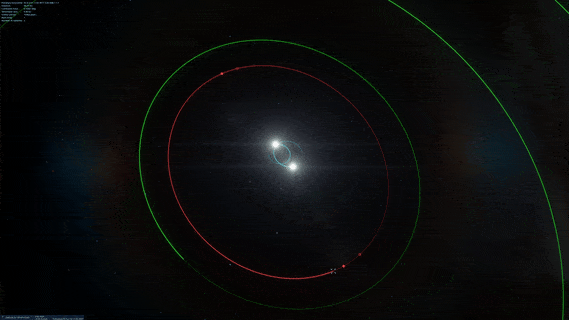How could one calculate eclipses on a planet (in a game) with one moon and orbiting two stars?
More Info:
Every so often--roughly every 5 years--the moon (this planet has a single moon) is in a position to cause a partial eclipse on the planet (i.e. blocking only one star). If you’re lucky, you may even witness a total eclipse where both stars are blocked. A full Synodic period for this planet is almost 11 years. I have yet to find a method to find out when such anomalies will occur next.
Eclipses occur roughly every 5 years. I do not know the month or the day or if there will be a total eclipse where both stars are blocked in a given year.
So far, I used this page to find the Saros period. Unfortunately, my calculations were off (can this page even be used for a double star system?). These sets of equations are also geared towards a moon that is on the same orbital plane as our moon which is not the case at all with this fictional moon and system.
A picture is worth 1,000 words so I will provide one here rather than further describe the star orbit:
1: Is there a way to calculate when eclipses will happen in this star system?
2: Is there a way to calculate if it will be a total eclipse (given the positions of the stars, center of mass etc.)?
The game is quite advanced; orbits are simulated and so is gravity. From what I can tell this is “as close as it gets” for a video game. Information regarding the orbits, masses, gravity, velocity and everything in between can be found within the game and provided here.
Nonetheless, I want to know how to do this just for fun even if it can’t be predicted within the game.
Here is the wiki pages for the game:
*https://en.wikipedia.org/wiki/SpaceEngine (wiki page)
https://se-database.fandom.com/wiki/Space_Engine_Database (planetary database)
http://spaceengine.org/ (main website)*
As a side note: I am referring to a solar eclipse that can be seen on the surface of this planet where one or both stars are blocked by the moon that orbits
EDIT:
The planet orbits both stars. As do the other planets.
There is a rather large Neptune like planet nearby which could be affecting the planet. Below are some more images/gif animations to show the system in more detail. The moon also appears to be affecting the orbit of the planet! Because of this, the planet has a slight wobble which is also shown below.
Planet Orbit (Planet orbit is highlighted in pink; the nearby Neptune planet is the next orbit):
Planet Wobble (most likely because of moon orbiting close by, its mass is is about half of the moon's but it is much closer at a distance of 83,799 km or 52,070 mi):
Moon Orbit Showing Eclipse (as mentioned before, every 5 or 6 years the moon goes through a cycle of eclipses blocking each star roughly 5 times depending on their positions):
Planet Data (gathered from game):
Inclination: -1 degree
Orbital Period: 10.802 years
Pericenter/Apocenter: 8.7571 AU/10.0095 AU
Mass: 0.16163 M⊕
Moon Data:
Inclination: 0 degrees
Orbital Period: 7.205
Diameter: 2,556 km or 1,588 mi
Mass: 0.55884 Lunar Mass or 0.00687 M⊕
Distance to Planet: 83,799 km or 52,070 mi
Neptune Planet Data:
Inclination: 0 degrees
Orbital Period: 7.205
Mass: 13.569 M⊕
Diameter: 361,859 km or 224,849 mi
Orbital Period: 15.481 years
Pericenter/Apocenter:11.0257 AU/12.8287 AU
Distance to Planet: 15.37 AU
Hill/Sphere of Influence: 0.14 AU/0.10 AU
There are many planets in it but the closest is the Neptune like planet.
We can also say that the game uses Keplerian orbits for simplicity; although this page (http://spaceengine.org/news/blog180817/) has a quote that confuses me slightly:
Previously, SpaceEngine used Kepler orbits – they are a good approximation of the motion of a planet around the Sun (or of a moon around a planet) without any perturbations. But the real Solar system is not so simple, we have multiple planets and moons which pull each other with their gravity.
I think this can be ignored for simplicity sake because it is more talking about our solar system not this procedurally generated one. Additionally, I am not sure that the engine is advanced enough to simulate exact orbits.




